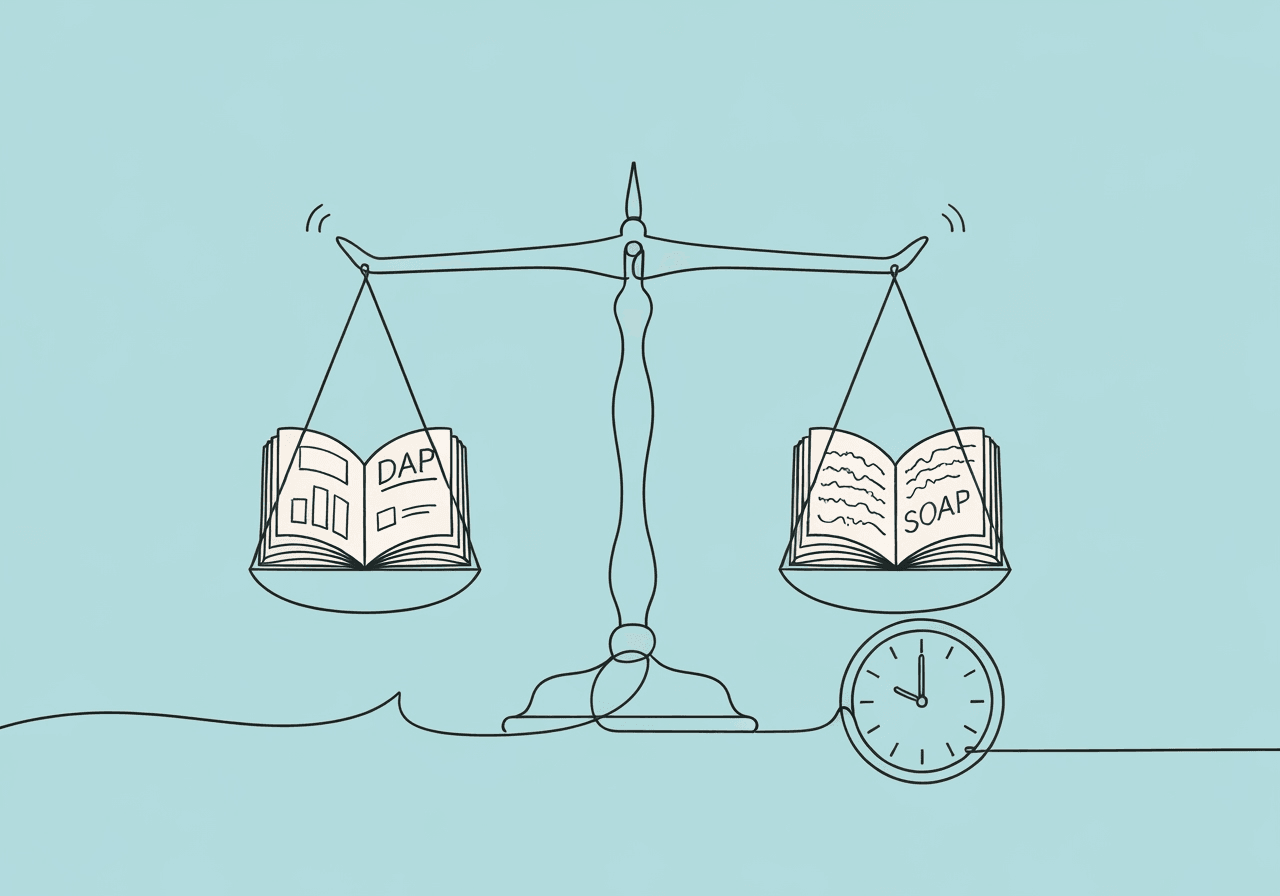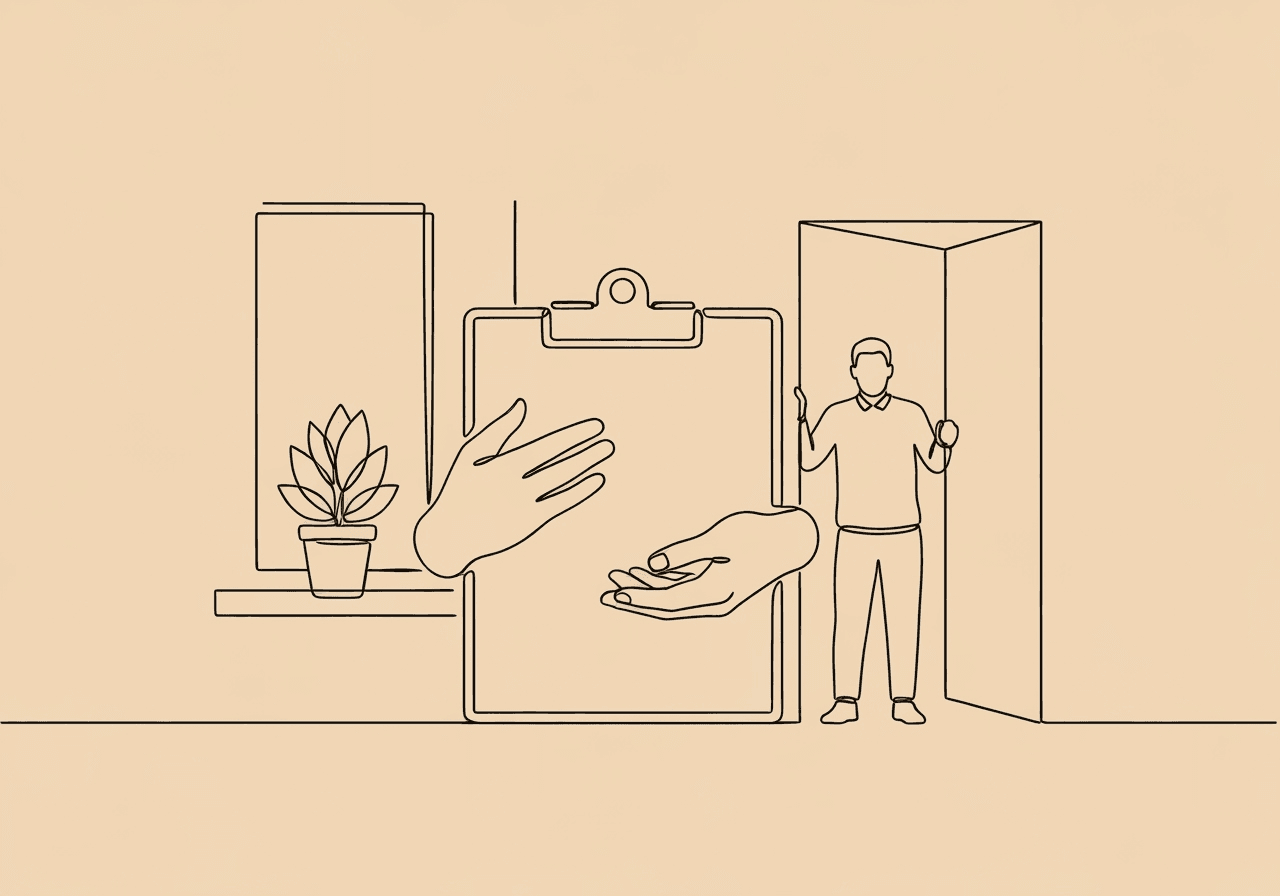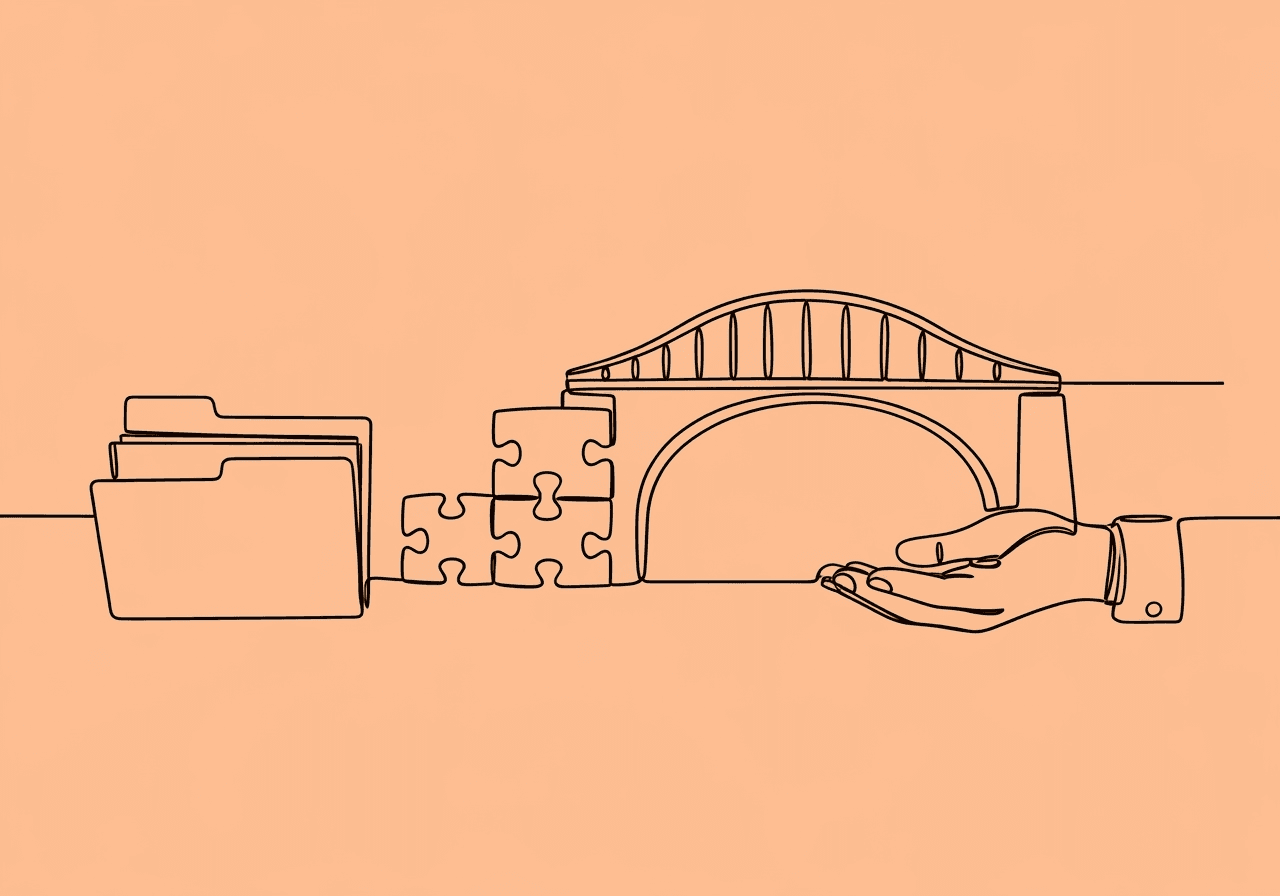SOAP vs DAP Notes in ABA: Key Differences

In ABA therapy today, accurate documentation forms the core of effective practice. For BCBAs and clinical directors, choosing between SOAP vs DAP notes ABA can make or break session efficiency while maintaining compliance. SOAP notes come from medical traditions and provide structured detail for complex cases. DAP notes simplify procedures for routine behavioral interventions.
This article breaks down these formats in detail. It covers their structures, strengths and weaknesses, and guidance on selection. You'll also get tips for documenting medical necessity and training your team.
Here are 3 key takeaways from this guide:
- SOAP notes excel in detailed analysis for complex ABA cases, like functional assessments.
- DAP notes boost efficiency for high-volume sessions, such as RBT-led routines.
- Both formats support compliance when you include objective data and timely signatures.
Understanding SOAP and DAP Notes in ABA
ABA therapy relies on precise records to track client progress. These records justify interventions and meet standards from the Behavior Analyst Certification Board (BACB). Both SOAP and DAP formats serve this purpose. Yet they cater to different needs in behavioral health documentation.
SOAP notes emphasize separating patient reports from clinical observations. In ABA, they support detailed analysis during supervision or reviews. DAP notes merge these elements for quicker entry. This aligns with ABA's data-driven, high-volume sessions.
According to professional guidelines from the Behavioral Health Center of Excellence (BHCOE), documentation must capture observable behaviors and intervention outcomes to demonstrate treatment efficacy. Choosing the right format depends on your caseload. Complex functional assessments (FAs) may demand SOAP's granularity. Daily RBT notes benefit from DAP's brevity.
The Structure of SOAP Notes in ABA
SOAP notes follow a four-part framework. These parts are Subjective, Objective, Assessment, and Plan. This structure ensures comprehensive capture of session dynamics. It makes SOAP ideal for BCBAs overseeing varied client needs.
In the Subjective section, record client or caregiver reports. Examples include expressed frustrations or self-reported skill improvements. For an ABA session targeting social skills, this might note a parent's observation of reduced anxiety in group settings.
The Objective section focuses on measurable data. This includes frequency of target behaviors or reinforcement schedules applied. BCBAs document specifics here. For instance: "Client completed 8/10 trials of manding with 80% independence using least-to-most prompting."
Assessment interprets the data. It links it to progress toward individualized education program (IEP) goals or behavior intervention plans (BIPs). It might state: "Client's manding skills show 20% improvement. This indicates effective discrete trial training."
Finally, the Plan outlines next steps. These include modifications or caregiver assignments. For more on creating compliant SOAP notes, check our ABA SOAP notes guide.
This format shines in settings requiring clear separation of perspectives. Resources from Sprypt Health note this benefit.
The Structure of DAP Notes in ABA
DAP notes condense documentation into three sections. These are Data, Assessment, and Plan. This approach suits ABA's emphasis on integrated behavioral insights. It reduces redundancy for busy clinicians.
The Data section combines subjective inputs with objective observations. In a routine RBT session, it could detail: "Client reported feeling excited about token economy. Observed 5 instances of cooperative play with latency under 10 seconds, using differential reinforcement."
Assessment evaluates this combined information against treatment goals. A BCBA might assess: "Token system maintained low-rate responding. No escape-maintained behaviors occurred. Progress aligns with BIP targets for social engagement."
The Plan then specifies future actions. Examples include fading prompts or monitoring collateral effects. For ready-to-use examples, explore customizable DAP notes templates that adapt to ABA workflows.
DAP's streamlined design supports faster completion. It often takes 5-8 minutes per note, as noted in resources from SimplePractice. This makes it practical for high-frequency sessions in home or school environments.
Key Differences: SOAP vs DAP Notes in ABA
The core distinction between SOAP vs DAP notes ABA lies in organization and depth. SOAP's four sections distinctly partition subjective reports from objective facts. This fosters analytical precision. DAP merges these into Data. It creates a narrative flow that prioritizes holistic session summaries.
In ABA, this affects data handling. SOAP's Objective section mandates quantifiable metrics like trial success rates. This aids in graphing progress for BACB-compliant reports. DAP's Data section allows blended entries. These can blur lines but accelerate routine logging for RBTs.
Time efficiency varies. SOAP suits in-depth reviews. DAP fits volume-driven practices. As outlined in comparisons from Freed AI, SOAP excels in multidisciplinary communication. DAP aligns with behavioral health's focus on integrated insights.
Both formats require objective language to uphold ethical standards. SOAP's structure may better prevent bias in assessments. For related insights on note styles, see our narrative vs data-driven ABA notes article.
| Aspect | SOAP Notes | DAP Notes |
|---|---|---|
| Sections | Subjective, Objective, Assessment, Plan (4 parts) | Data, Assessment, Plan (3 parts) |
| Focus | Separates reports from data for precision | Merges inputs for narrative flow |
| Best For | Complex cases, audits, multidisciplinary reviews | Routine sessions, high-volume workflows |
| Time Estimate | 10-15 minutes per note | 5-8 minutes per note |
| ABA Application | Detailed graphing, IEP/BIP alignment | Quick RBT logging, integrated insights |
Strengths and Weaknesses: Efficiency, Compliance, and Clinical Depth
Each format offers unique advantages in ABA. These come with trade-offs in efficiency and compliance.
SOAP notes provide robust clinical depth. Separated sections enable thorough audits and payer reviews. Their strength lies in compliance for complex cases, like functional assessments. Distinguishing client perceptions from data supports medical necessity claims. However, the added structure can extend documentation time. This may strain resources in high-caseload clinics.
DAP notes prioritize efficiency. They combine elements for quicker entries. This keeps BCBAs focused on intervention over paperwork. DAP's weakness may emerge in detailed compliance needs. Merged Data sections risk overlooking subtle subjective nuances. These are critical for insurance appeals.
According to BHCOE standards, both meet ABA documentation requirements if they include identifiable elements like session times and signatures. For insurance contexts, SOAP's detail minimizes denials, as supported by Artemis ABA. DAP's brevity aids daily consistency. Weaknesses aside, integrating either with tools like Praxis Notes' AI templates enhances accuracy across formats.
In clinical depth, SOAP supports nuanced BIPs. DAP's narrative style can reveal behavioral patterns more fluidly in routine therapy.
Choosing the Right Format and Ensuring Medical Necessity
Selecting between SOAP and DAP depends on your clinical setting and payer guidelines. For complex FAs or team-based care, SOAP's separation clarifies evidence for progress reports. Routine RBT sessions thrive with DAP's efficiency. This is especially true under time constraints like CPT 97153 billing.
Payer requirements, such as those from Aetna or Medicaid, emphasize medical necessity. They require objective data tying interventions to symptom reduction, per Aetna's ABA medical necessity guide. In both formats, document baseline behaviors, intervention specifics, and measurable outcomes. For example: "Intervention reduced elopement from 4/10 to 1/10 opportunities."
To ensure compliance, include session identifiers (date, duration, location) and timely signatures within 24 hours, as outlined in best practices from Your Missing Piece. Avoid subjective phrases. Focus on observables like latency or intensity. For payer-specific tips, refer to our insurance-ready ABA session notes resource.
Hybrid approaches can optimize for diverse caseloads. They blend DAP's speed with SOAP's detail via templates. Always align with BACB Ethics Code 2.09 for accurate records.
Practical Tips for Training RBTs on Note Consistency
Training RBTs to maintain consistent notes builds a reliable practice foundation. Start with format-specific workshops. Demonstrate SOAP's sections via role-play. Show how to log observables separately from reports.
For DAP, emphasize integrated Data entries while reinforcing objectivity. Use checklists like "What data supports the assessment?" Provide BCBA session notes formats as hands-on examples.
Incorporate feedback loops. Review sample notes weekly. Highlight compliance gaps like missing plans. Leverage tools for auto-population to reduce errors.
Address transitions, such as switching from DAP to SOAP for audits. Pair training with simulations. As per Your Missing Piece best practices, consistent training reduces documentation errors by fostering habit. For broader RBT guidance, explore our ABA documentation best practices for RBTs.
Frequently Asked Questions
Which note format is more efficient for ABA therapy sessions?
DAP notes are generally more efficient for routine ABA sessions. They take 5-8 minutes to complete by combining subjective and objective data into one section. This suits high-volume RBT workflows, as noted in comparisons from SupaNote AI. SOAP notes require 10-15 minutes and fit better for in-depth analysis, per Cube Therapy Billing.
How do DAP notes impact overall documentation time in ABA therapy?
DAP notes reduce documentation time by streamlining the process. This allows BCBAs to focus on client care over paperwork. Resources from Freed AI indicate this format cuts entry time without compromising key elements like progress tracking. It makes DAP ideal for daily ABA sessions under time pressures.
Are there specific scenarios where SOAP notes are preferred over DAP notes in ABA therapy?
Yes, SOAP notes are preferred for complex cases like functional assessments or multidisciplinary reviews. Separating client reports from observations clarifies clinical reasoning. According to Ditto Transcripts, this structure supports detailed payer audits. It differs from DAP's blended approach for routine behavioral interventions.
What are the key elements to include in daily ABA session notes?
Daily ABA session notes must include patient identifiers (name, DOB). They also need session details (date, time, location), treatment descriptions with objective data (behavior frequencies, intervention outcomes), and signatures. BHCOE guidelines stress timeliness—within 24 hours—to demonstrate medical necessity and compliance.
How can BCBAs ensure ABA session notes are compliant with insurance requirements?
BCBAs ensure compliance by documenting measurable progress tied to treatment goals. Use objective language and include all required identifiers. Per Aetna's medical necessity guide, notes should justify ongoing therapy with data on symptom changes. Tools like templates help avoid common pitfalls like vague assessments.
What are best practices for writing objective data in SOAP or DAP notes?
Best practices include quantifying behaviors (e.g., "3 instances of compliance"). Avoid interpretive words like "good." Link data to goals. Raven Health recommends using consistent metrics across sessions. This supports BIPs and insurance claims in both formats.
In weighing SOAP vs DAP notes ABA, the choice hinges on balancing detail with practicality. SOAP fits precision in complex scenarios. DAP suits streamlined routines. Both uphold compliance when rooted in objective data. This fosters ethical ABA practice that prioritizes client outcomes.
For BCBAs and clinical directors, implement these insights by auditing current notes against payer standards. Then select a primary format with hybrid flexibility. Next steps include reviewing your team's documentation for gaps. Pilot DAP for routine sessions. Train on medical necessity phrasing using verified templates. This approach boosts efficiency. It also ensures reimbursements and quality care. Your practice will thrive as a result.
Popular in ABA Session Notes & Tools
- 1
RBT Supervision Documentation: 2025 BACB Guide & Templates
1,2469 min read - 2
Master ABA Medical Necessity Documentation: Avoid Denials
5719 min read - 3
Master ABA SOAP Notes: Guide for RBTs & BCBAs
5239 min read - 4
ABA Documentation Best Practices for RBTs: Essential Tips
4935 min read - 5
Guide to ABA Progress Reports for Insurance Reauthorization
4258 min read
Popular in ABA Session Notes & Tools
- 1
RBT Supervision Documentation: 2025 BACB Guide & Templates
1,2469 min read - 2
Master ABA Medical Necessity Documentation: Avoid Denials
5719 min read - 3
Master ABA SOAP Notes: Guide for RBTs & BCBAs
5239 min read - 4
ABA Documentation Best Practices for RBTs: Essential Tips
4935 min read - 5
Guide to ABA Progress Reports for Insurance Reauthorization
4258 min read
Related Resources
Explore more helpful content on similar topics

BCBA Session Variation Documentation: Ethical Guide
Learn ethical BCBA session variation documentation for unforeseen circumstances in ABA therapy. Our step-by-step guide and templates ensure BACB compliance and accurate session notes.

Essential 9 Steps for Standardized BCBA Note Templates
Learn 9 essential steps to create standardized BCBA note templates that enhance ABA EHR efficiency and ensure compliance. Streamline session documentation and link seamlessly to treatment goals—start today!

RBT Supervision Documentation: 2025 BACB Guide & Templates
Master RBT supervision documentation with the 2025 BACB guide. Learn compliance rules, 5% supervision requirements, telehealth best practices, and free templates for audits and quality care. Download now!